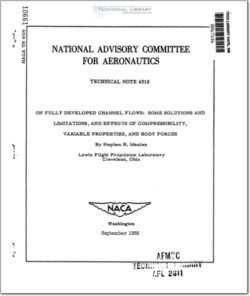NACA-TN-4319

- Version
- 167 Downloads
- 1.40 MB File Size
- 1 File Count
- December 4, 2015 Create Date
- December 4, 2015 Last Updated
National Advisory Committee for Aeronautics, Technical Notes - On Fully Developed Channel Flows: Some Solutions and Limitations, and Effect of Comprehensibility, Variable Properties and Body Forces

An examination of the effects of compressibility, variable proper-
ties, and body forces on fully developed laminar flows has indicated
several limitations on such streams.
In the absence of a pressure gradient, but presence of a body force
(e.g., gravity), an exact fully developed gas flow results. For a liquid
this follows also for the case of a constant streamwise pressure gradient.
These motions are exact in the sense of a Couette flow. In the liquid
case two solutions (not a new result) can occur for the same boundary
conditions. An approximate analytic solution was found which agrees
closely with machine calculations.
In the case of approximately exact flows, it turns out that for
large temperature variations across the channel the effects of convec-
tion (due to, say, a wall temperature gradient) and frictional heating
must be negligible. In such a case the energy and momentum equations
are separated, and the solutions are readily obtained. If the temper-
ature variations are small, then both convection effects and frictional
heating can consistently be considered. This case becomes the constant-
property incompressible case (or quasi-incompressible case for free-
convection flows) considered by many authors.
Finally, there is a brief discussion of cases wherein streamwise
variations of all quantities are allowed but only in such form that the
independent variables are separable. For the case where the streamwise
velocity varies inversely as the square root of distance along the chan—
nel, a solution is given.
Among all possible fluid flows, one of the most useful is the fully
developed (i.e., independent of streamwise distance) channel flow. The
flow is taken to be the motion generated by a constant pressure gradient
(the familiar Poiseuille flow) or by a body force (ref. 1). In either
case one usually considers only an incompressible or quasi-incompressible
flow with fixed fluid properties. This is in marked contrast to the case
of.Couette flow where two parallel walls move with respect to each other.
| File | Action |
|---|---|
| naca-tn-4319.pdf | Download |

Comment On This Post